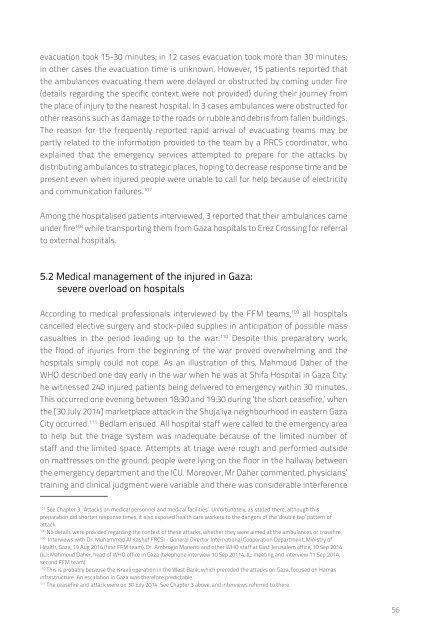HHo0s
HHo0s
HHo0s
You also want an ePaper? Increase the reach of your titles
YUMPU automatically turns print PDFs into web optimized ePapers that Google loves.
evacuation took 15-30 minutes; in 12 cases evacuation took more than 30 minutes;in other cases the evacuation time is unknown. However, 15 patients reported thatthe ambulances evacuating them were delayed or obstructed by coming under fire(details regarding the specific context were not provided) during their journey fromthe place of injury to the nearest hospital. In 3 cases ambulances were obstructed forother reasons such as damage to the roads or rubble and debris from fallen buildings.The reason for the frequently reported rapid arrival of evacuating teams may bepartly related to the information provided to the team by a PRCS coordinator, whoexplained that the emergency services attempted to prepare for the attacks bydistributing ambulances to strategic places, hoping to decrease response time and bepresent even when injured people were unable to call for help because of electricityand communication failures. 107Among the hospitalised patients interviewed, 3 reported that their ambulances cameunder fire 108 while transporting them from Gaza hospitals to Erez Crossing for referralto external hospitals.5.2 Medical management of the injured in Gaza:severe overload on hospitalsAccording to medical professionals interviewed by the FFM teams, 109 all hospitalscancelled elective surgery and stock-piled supplies in anticipation of possible masscasualties in the period leading up to the war. 110 Despite this preparatory work,the flood of injuries from the beginning of the war proved overwhelming and thehospitals simply could not cope. As an illustration of this, Mahmoud Daher of theWHO described one day early in the war when he was at Shifa Hospital in Gaza City:he witnessed 240 injured patients being delivered to emergency within 30 minutes.This occurred one evening between 18:30 and 19:30 during ‘the short ceasefire,’ whenthe [30 July 2014] marketplace attack in the Shuja’iya neighbourhood in eastern GazaCity occurred. 111 Bedlam ensued. All hospital staff were called to the emergency areato help but the triage system was inadequate because of the limited number ofstaff and the limited space. Attempts at triage were rough and performed outsideon mattresses on the ground; people were lying on the floor in the hallway betweenthe emergency department and the ICU. Moreover, Mr Daher commented, physicians’training and clinical judgment were variable and there was considerable interference107See Chapter 3. ‘Attacks on medical personnel and medical facilities’. Unfortunately, as stated there, although thispreparation did shorten response times, it also exposed health care workers to the dangers of the ‘double tap’ pattern ofattack.108No details were provided regarding the context of these attacks, whether they were aimed at the ambulances or crossfire.109Interviews with Dr. Muhammad Al Kashef FRCSI - General Director International Cooperation Department, Ministry ofHealth, Gaza, 19 Aug 2014 (first FFM team); Dr. Ambrogio Manenti and other WHO staff at East Jerusalem office, 10 Sep 2014(JL); Mahmoud Daher, head of WHO office in Gaza (telephone interview 10 Sep 20114, JL; meeting and interview 11 Sep 2014,second FFM team).110This is probably because the Israeli operation in the West Bank, which preceded the attacks on Gaza, focused on Hamasinfrastructure. An escalation in Gaza was therefore predictable.111The ceasefire and attack were on 30 July 2014. See Chapter 3 above, and interviews referred to there.56


